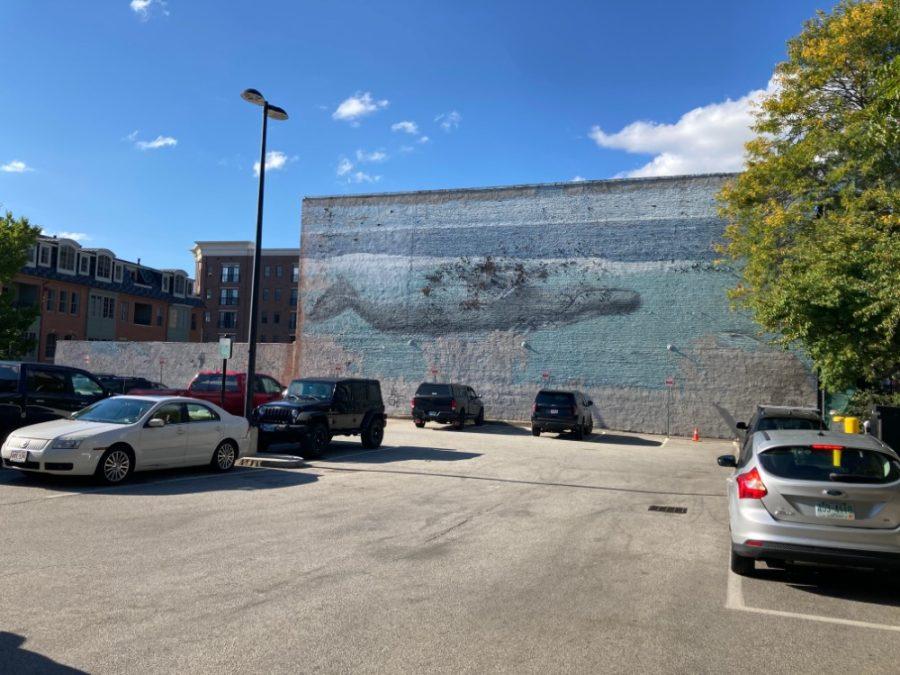Saying goodbye to the beloved Portsmouth whale wall
October 13, 2021
For current and previous Portsmouth citizens, the famed Whale Wall overlooking the Worth parking lot has been a source of pride for the past 28 years. However, the mural is now undergoing deconstruction which has received an array of reactions from the Portsmouth public.
The mural was originally painted in 1993 by famous muralist, Robert Wyland, according to principal planner for Portsmouth, Nick Cracknell. Wyland is known for his magnificent paintings of marine life and for the Wyland Foundation which advocates for the protection of oceans and marine life.
The front two-thirds of the building itself where the mural was painted was constructed in 1898. The remaining third was built about 10 years later. The building was formerly a furniture store and recently sold to a developer.
“There are a number of challenges that any community looking at large canvases of public art need to be cautious of,” said Cracknell. “One is the issue of maintenance and preservation of the art itself. The other is the responsibilities and obligations between owner and artist.” He added that sometimes this extends to the public or government if they are involved.
According to Cracknell, because there was never an easement put on the property for the mural to be painted “there was no legal obligation of the private property owner, both seller and buyer, to retain that mural even in its faded, dilapidated form.”
Steve Wilson, the new developer, has proposed a multi-use building with commercial spaces on the ground floor and residential units on the upper floors.
“In order to activate and program that building to function with its dimensions, it required openings to be placed into the Whale Wall side of the building which was going to have a pretty profound impact on how that wall projects to the passerbyer,” said Cracknell. Windows and balconies will be placed on the wall for the residential units.
The other factor that impacted the decision was the condition of the building.
“The 800-pound gorilla is the fact that the mural is faded, its delaminating and it’s undermining the integrity of the building,” said Cracknell.
He explained that during the last 15 years, someone decided to put a sealant on the wall to try and preserve it. However, it had an adverse effect, stopping water transfer from the inside to the outside of the building. “Bricks are falling inside the building onto the floor and on the outside, the bricks are turning back into sand and taking the mural with it,” said Cracknell.
Portsmouth residents have expressed a multitude of opinions on the deconstruction of the Whale Wall and the implementation of new apartments in the building.
“Apartments[are] the only move,” said current Portsmouth resident, Jason Walls. “We need housing, and we need it badly. Portsmouth’s vacancy rate for rentals is under two percent; a healthy rate is six to eight percent. For homes it’s even worse: close to zero percent.”
“We need to do whatever we can to allow the market to build what it needs and wants to build,” said Walls. “Whatever happens, they definitely should welcome more street art. That’s something the city can help promote.”
“I am sad to see the wall go,” said Jennifer Lentz, former Portsmouth resident. “I think it is a bad move on part of the city. I wish there was more effort put into restoration.”
According to Cracknell, the wall would have been unable to be painted or cleaned, as a large portion of the brick would have to be replaced.
Lentz expressed that she would rather see a community space, and more charismatic and artistic spaces being put into the building.
“I hope that some tribute to the wall or a small replica of the wall is left behind to make sure we don’t forget about this piece of modern Portsmouth history,” she said.
“The building being changed is a natural evolution of the city,” said current Portsmouth resident, Laura Koulet. “The ability to find good housing is a well-known challenge, so I hope that the new apartments will expand the availability of downtown housing.” She also hopes the owners will keep the prices affordable so the city can continue to attract young workers and create a thriving and youthful downtown.
Saying goodbye to the Whale Wall is bittersweet, especially for those who have grown up passing the friendly mural every time they ventured into downtown Portsmouth. But even when the Whale Wall is no longer there, the fond memories of it will forever live on as a piece of Portsmouth’s history.






























